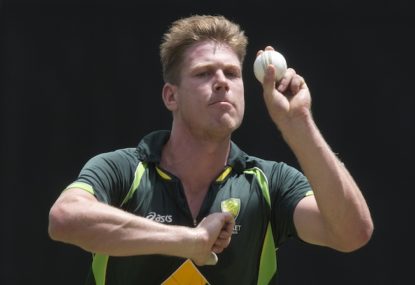Faulknered (v) – to have suffered an unlikely one-day defeat at the hands of an effective, but ungainly-looking Tasmanian allrounder.
E.g., “England have been Faulknered several times on Australian shores in the last twelve months.”
At least that’s the way I use the word. It’s just such a all encompassing description of what this wonderful player can do to a game of cricket, that it seems fitting that James Faulkner’s efforts should be turned into a word. And, literally, England have been ‘Faulknered’ numerous times in the last year.
And it’s been wonderful.
Except that now Australia’s World Cup chances have been Faulknered. And the word I invented twelve months ago has come back to bite me on the arse, big time.
The look on the faces of Dr Peter Brukner and Coach Darren Lehmann when Faulkner arrived back in the Australian dressing room at the WACA mid-over last Sunday told the story: Australia had just suffered an injury that will have much more impact on the balance of the one-day side than any other.
Officially, Faulkner has picked up “a moderate grade abdominal muscle strain which is consistent with a ‘typical’ fast-bowing side strain injury,” the Australian team physio, Alex Kountouris said on Tuesday afternoon via CA statement.
Faulkner will stay with the side for now as they begin World Cup preparations in Adelaide, where he “will receive intensive treatment for the next two weeks before we can determine when he can return to batting and bowling.”
Two weeks from Tuesday puts him out until at least February 17, which for those thumbing your way through the World Cup schedule is three days after Australia’s first game of the tournament against England in Melbourne, and four days before the second game, against Bangladesh in Brisbane.
You might remember the Bangladesh game as the deadline for Michael Clarke to prove he’s 100 per cent fit after his hamstring surgery. Or, if you take some reporting as gospel, the Cricket Australia-determined day of cricketing apocalypse, where the haters and apologists will face off with pitchforks and burning torches, and shout from the rooftops why they were right. Much bonhomie should ensue.
But never mind the National Hamstring for the moment. If Clarke can’t complete a run-of-three in his full batting kit at Usain Bolt pace by the 17th – or whatever the official fitness test is – then he’ll be replaced in the squad. Shaun Marsh or Cameron White will come in, and that will be that. Easy. Next problem…
The Faulkner conundrum is so much more complex because of what he brings to the side.
A Tri-Series batting return of 100 runs with three red inks from four knocks, and a strike rate of 125, tells you he’s been outstanding coming in six wickets down. Six wickets at 30.6 and a wicket every six overs is more than useful, too.
But these figures are also well in line with Faulkner’s career figures, so it’s not even just one really good series to pick off as an outlier. In 38 ODIs Faulkner averages 48 with the bat and 32.4 with the ball, striking at 111.1 and 34.4 respectively.
It’s this kind of consistency that has allowed the Australian side to play so many allrounders, and even play several players in the middle order where batting form and team output doesn’t necessarily demand retention.
It’s very easy to stick with Brad Haddin at seven averaging only a tick over 30 with the bat, when you have a bloke at eight capable of smashing 50 off 43 to close out most innings.
In fact, Faulkner’s ability with the bat also allows the likes of Glenn Maxwell and Mitchell Marsh to play in the middle order, and for there to be not too much concern if or when they don’t come off. Mitchell Johnson striking at near a run-a-ball at nine obviously helps, too.
And this is why I don’t think it’s as easy as saying “just replace him with a bowler” as Ronan O’Connell suggested on Wednesday. Yes, someone like Pat Cummins or Josh Hazlewood could do the job with the ball, and Johnson could come off up one spot in the batting order, but the margin for error is increases significantly.
With no Faulkner at eight, I’d be very nervous about a middle order of Maxwell-M.Marsh-Haddin, even on the back of Maxwell and Marsh putting on 141 for the fifth wicket last Sunday in Perth. In fact, when Maxwell threw away his maiden ODI ton in the 41st over, Marsh and Haddin followed soon after, as Australia lost 3/23 by the end of the 45th.
In reality, if Faulkner has to be replaced, it nearly has to force a complete rethink of the balance of the side. They could go with Moises Henriques again, but even in the reasonable all-round form he’s in currently, the side would still feel light on in both the bowling and batting departments.
Therefore, if a bowler comes in, I can’t see how the Maxwell-Marsh-Haddin middle order stays intact. Shane Watson has to come back in somewhere obviously, too, but does he strengthen the batting enough? Does Australia go back to the tried and trusted six bats-four bowlers model?
What is obvious is that Faulkner just cannot be ruled out of the World Cup. Put him in the same cotton wool usually reserved for Ryan Harris for two weeks by all means, but just get him right.
Australia is ranked number one for the World Cup, but it’s hard to see that remaining with no James Faulkner in the squad.





























































































